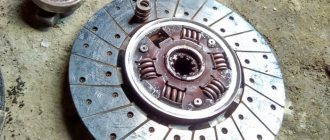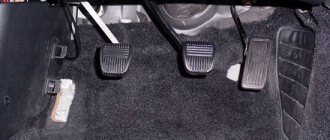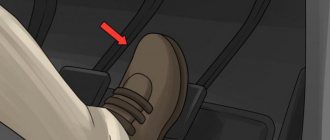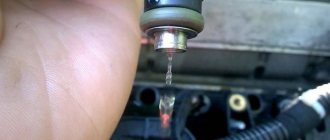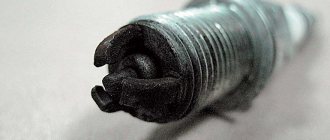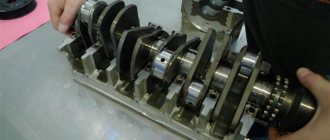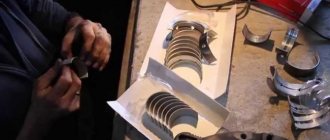Clutch slipping in a passenger car is a common malfunction that leads not only to inconvenience in driving the car, but also to unplanned financial costs. Failure occurs due to improper operation of the transmission system and untimely maintenance.
A detailed review will help the car owner figure out why the VAZ 2107 clutch is slipping, and will introduce you to ways to fix the problem yourself, without resorting to the help of a service station.
The driver can detect slippage as follows:
- Difficult gear shifting, a kind of crunching sound.
- The car moves poorly and begins to slip.
- When driving fast in lower gears it jerks (working jerks).
- Loss of power when climbing.
- Vibration or noise occurs.
- Pedal device failure.
Why is this happening?
To understand why the clutch slips on a VAZ 2107, you need to understand its structure and operating principle.
The entire mechanism consists of the following elements:
- crankcase;
- driven disk of the basket;
- riveted friction linings;
- diaphragm spring;
- pressure plate;
- hydraulic clutch release.
The parts are placed in a steel basket; The driven disk contains splines and damper springs that ensure smooth gear shifting.
The operating principle is based on friction between the working parts. The clutch connects the power unit and the transmission and transmits torque from the engine flywheel to the intermediate shaft of the vehicle's gearbox. When you press the pedal, the disc moves away, the connection between the motor and the gearbox is disconnected, and the rotation of the gearbox shaft stops. When the pedal is released, the flywheel and gearbox shaft are connected, and rotation is transmitted to the gearbox.
The coupling device slips for the following reasons:
- Oil leakage, liquid getting on the surface of the basket parts.
- Overheating of the drive disk. When the temperature is exceeded during use, the discs expand. This phenomenon is not noticeable on the go. It is determined during inspection of the part. Soot deposits and fumes are visible on the surface.
- Wear or delamination of friction linings. The elements not only wear out, but can also get burned. An unpleasant odor appears in the car interior.
- Damaged or worn compression spring. If there are defects, the spring is not able to create the required pressure on the disk.
- No gaps in the shutdown hydraulic drive.
- Reduced freewheel parameter.
Experts combine the reasons why this happens into 2 groups:
- The hitch does not fully engage (drive). Due to the increased distance of the pedal to the platform.
- The clutch does not fully engage (slips). The discs slip relative to each other, and the pedal stroke decreases.
How to check whether the clutch is slipping or not
To check the system yourself without special technical devices, perform the following steps:
- Turn on the engine and set it to neutral.
- Release the parking brake.
- Press the gas lever.
- Engage first gear.
- Squeeze the pedal.
- Squeezing is done several times.
When the assembly is operating correctly, the engine stalls. If the engine does not turn off, or there are extraneous sounds (clicks, creaks, knocks) and a burning smell, the clutch is considered faulty. Particular attention is paid to pedal travel. The lever should lower smoothly, without jerking or interruption.
What to do when the clutch slips
Depending on the cause of slipping, the progress of repair and restoration work is determined.
If the fault lies in the pressure spring, it must be replaced with a new one. When the friction linings are worn, the driven disk is replaced. When repairing or replacing some linings, be sure to inspect the gaskets. If they are damaged or have burnt spots, they are also replaced. If oily liquid gets on parts of the driven disk, it is necessary to treat the surface with kerosene or white spirit and clean it with fine-caliber sandpaper.
Grease may get on the surface of the flywheel and pressure plate if the fluid level in the gearbox housing increases excessively or if there is a leak in the rear crankshaft bearing. To solve the problem, carry out visual diagnostics and eliminate the cause of the leak, then clean the parts.
The car repair instructions will tell you what to do if there are no gaps in the hydraulic drive or insufficient free play of the lever.
The free stroke according to the specifications is 30-35 mm, the full stroke is 140 mm. Any deviation of the parameter is associated with a malfunction of the transmission system and requires adjustment work to change the pedal stroke and the position of the disk relative to the flywheel.
Considering the vulnerability of the clutch due to inept operation, experts recommend examining the amount of travel when undergoing maintenance. The parameter is checked using a measuring ruler. To do this, measure the distance from the pedal to the central part of the platform.
Repair work is carried out inside the car using open-end wrenches 13x17 mm and 17x19 mm. The M10 adjusting nut is screwed onto the tip. Tightening and unscrewing the element increases or decreases the distance from the pedal lever to the floor. The pusher should first be treated with a universal WD-40 aerosol to remove dried dirt. The pusher adjustment nut is turned with rotational movements to the required value, a 17 wrench is used to prevent rotation, and the control fastener is loosened with a 13 wrench.
Upon completion of work, tighten the locknut so that the settings do not go astray. The adjusted clutch is checked by squeezing the pedal several times, after which the distance from the floor is re-measured.
On a VAZ 2107, adjustment of the free play of the fork rod is performed in the inspection ditch. The fork can deviate within 2-4 mm.
The amount of pedal travel minus its free play
Algorithm for performing the procedure for adjusting the free play of the fork:
- Using pliers, remove the ends of the return spring under the fasteners of the working cylinder.
- The adjusting nut is held with a 17 key, the main fasteners are loosened with a 13 key.
- The rod is locked using adjustable Cobra pliers.
- By rotating the wrench by 17 on the adjusting nut, the free stroke of the rod is adjusted.
- Tighten the locknut.
Checking the clutch operation:
- Start and warm up the engine to operating temperature.
- Squeeze the pedal.
- Switch to first gear.
- Turn off and go into reverse.
During normal operation, the clutch does not drive, is easily squeezed out and does not jam. Damage to the part and incorrect settings contribute to the need to replace the coupling.
The VAZ 2107 clutch is a part of the transmission mechanism that is involved in transmitting torque to the drive wheels of the car. The clutch is located between the gearbox and the car engine and transmits rotation from the engine to the gearbox. When the pedal is pressed, the clutch is released and the engine is separated from the gearbox. When the pedal is released, the connection is restored again. The clutch ensures smooth starting of the car and silent gear shifting.
Basic faults
The slave cylinder has several rubber seals, which often become unusable or become oily, causing the car’s clutch to “slip.” Replacing old seals with new ones will require using a lift or inspection hole, since the main cylinder is located in an inconvenient place.
When replacing seals, do not forget that there is brake fluid in the system; it must first be drained.
It is advisable not to touch the flare nut, otherwise additional adjustment will be required later. In order to replace the gaskets without removing the master cylinder, certain skills and experience are required.
Another cause of clutch malfunction may be wear of the release bearing.
To replace it, you will have to dismantle the gearbox. Brake disc linings wear out just as often, which is easy to notice by the characteristic noise when the pedal is released. And the most common problem with a clutch malfunction is air getting into the system. Air can be removed by bleeding.
Causes of clutch slipping
There may be several reasons causing this effect. As a rule, they arise due to a characteristic driving style, which is commonly called sporty. Sharp acceleration and braking, frequent gear changes significantly reduce the working life of the clutch, although AvtoVAZ defines it as 75-85 thousand kilometers. In addition, experts say that the performance of a car’s clutch can be significantly affected by the use of trailers. It is believed that they are capable of significantly shortening the life cycle of components and mechanisms of an automotive element. Let's look at the most common actual causes of clutch slipping.
Leveling up
To bleed, you will need brake fluid and a container for draining it, as well as a transparent hose with a diameter of 5mm. and an assistant who will have to press the clutch pedal until heaviness appears in it. After this, it must be clamped, and at this time a second person must unscrew the fitting and drain all the brake fluid. Air bubbles will be visible in the hose. The procedure should be repeated until these same bubbles disappear. Also, do not forget about the fluid level in the expansion tank.
Installing the clutch master cylinder repair kit
It is not difficult to determine when it is necessary to repair the master cylinder; the main signs of its malfunction are:
- Insufficient clutch release (clutch drives)
- Any type of leakage, whether from under the nuts securing the hose and tubes, or from the end from under the rubber seals
- Master cylinder stuck in pressed position
In my situation, the main leak was due to a worn out sealing ring, in other words, fluid flowed down the clutch pedal into the passenger compartment.
I started the repair by dismantling the reservoir hose, unscrewed the clamp on the main cylinder and quickly removed it from the main cylinder, turned it up and pinched it behind the reservoir cap so that the liquid did not flow out of the reservoir. Next, I unscrewed the tube that goes to the working cylinder, I did this with a special key, it’s a pity there is no photo, but you can buy one without any problems at any auto store. All that remains is to unscrew the main one itself, it is secured with two 13 nuts and remove it from under the hood.
Main removed
The boot was removed and it was noticeable that fluid was flowing from here.
Having picked up the boot with a screwdriver, I saw exactly where the liquid was flowing from; the assumption was absolutely correct.
Next, you need to wipe the cylinder, remove dirt and rust.
After cleaning the dirt, you can begin disassembling. To do this you will need an awl or similar object.
Corkscrew ring
Corkscrew ring
We take out the ring
Next, you need to carefully remove the insides, keeping in mind that the piston is under the action of a spring.
This is what it looks like
Next, you need to clean the master cylinder body, you cannot scrape the parts with a screwdriver, sandpaper, etc., this is just in case, I use a rag with brake fluid. In repair manuals, I often came across such expressions that if rips, scratches, etc. appeared on the parts, then it is unusable. But despite all this, practice shows that despite all the risks, provided that a high-quality repair kit is installed, the master cylinder works without problems. I used this kit:
Repair kit for clutch master cylinder VAZ
We remove the old rings, clean all the grooves and holes. There should be no dust or debris there.
The ring is removed, clean the piston, install a new one
Pure "Innards"
And by the way, here is the reason for the clutch cylinder leaking:
The ring is not worn evenly
After cleaning and replacing the rings, you can assemble the cylinder, below is a photo of what should be there and how:
Here is a photo not cleaned, I added it here to show the correct assembly
Having assembled the cylinder, install the corkscrew ring
Bleeding the clutch on a VAZ 2106
After the repair has been made, it is necessary to bleed the clutch. In all repair manuals you can find standard instructions for bleeding the clutch, but it may not always help.
- The first bleeding option is standard; it consists of filling the tank with liquid, unscrewing the bleeding fitting, putting a hose on the fitting, and lowering the other end into a container with clean liquid. Then, by pressing the pedal, we monitor when the air stops being released, and also do not forget to control the level in the tank.
- The second method is to use an assistant - one person presses the pedal 4-6 times and keeps it pressed to the floor. The second unscrews the bleeder fitting; air bubbles should come out of the fitting; as soon as they stop coming out, you need to screw the fitting in and then release the pedal. And so on until normal operation of the pedal is restored and air bubbles stop coming out.
- There is also the simplest method of pumping, but which does not always work - to implement it you just need to pour liquid into the reservoir and unscrew the fitting on the working cylinder. The liquid will flow by gravity through the entire system and when it begins to flow steadily out of the fitting, it can be closed and the pumping can be considered complete.
Adjustment
Clutch adjustment on a VAZ 2107 is carried out by adjusting the clutch drive, or rather, the adjusting bolt, which is located at the end of the cable in the engine compartment. Incorrect adjustment causes the clutch to slip.
- The car is installed on an overpass or inspection hole.
- In the cabin, the free play of the clutch pedal is checked and, if necessary, adjustments are made. To do this, use a 10mm wrench to loosen the locking nut of the pedal stop and set the required gap, approximately 0.4-2 mm.
- The pusher is cleaned of dirt and a penetrating lubricant is applied.
- The working cylinder is checked for free play of the pusher, on which the free play of the release bearing depends. To do this, push the clutch fork back by hand until it stops, while the free play of the pusher should be within 4-5 mm.
- Adjustment of the free play of the pusher is done with a 17 wrench, which will keep the adjusting nut from turning, and with a 13 wrench, loosen the tightening of the lock nut.
- The pusher is held with a key at 8, at the same time with a key at 17
- The adjusting nut is loosened and the required free play of the pusher is set, this is approximately 4-5 mm.
- The locknut is tightened by holding the pusher adjusting nut.
- Inside the car, the total free play of the clutch is checked, which should be approximately 25-30 mm. from the top position of the pedal to the start of switching on. If necessary, the entire operation is repeated several times until it is felt that the clutch is no longer slipping.
Insufficient pedal free play
The clutch often slips (the VAZ-2107 often suffers from this) also because the pedal has too little free play.
There are other reasons why the clutch of VAZs of any model, and the “Seven” in particular, slips.
- Detachment of the friction lining. The lining itself may not have visible damage or burnt areas. But as a result of delamination, it ceases to take the load over its entire surface, which leads to slipping.
- Overheating of the release disc. As a result of the temperature exceeding the maximum possible heat-absorbing characteristics of the clutch disc, it permanently expands, which causes a slipping effect. Of course, this defect cannot be determined on the fly. But it can be determined quite easily by the characteristic residue of burning and scale on the disk itself.
This article lists the main reasons why the clutch slips on domestic classics and on many other models of cars and trucks. It is important to remember that, whatever the cause of clutch slipping, it must be eliminated at the first appearance of symptoms of the defect. It is best to entrust such work to highly qualified specialists.
In addition, when doing repair work yourself, there is a fairly high risk of violating the correct settings and adjustments, which will turn replacing parts into a Sisyphean task. Very soon the clutch will again begin to slip, make grinding and crackling noises, and the smell of overheated discs and linings will be clearly felt in the car's interior.
Replacing the master and slave cylinders
The master cylinder is replaced in the following sequence:
- Liquid is drained from the reservoir. This can be done using an ordinary syringe, or by removing the hose from the master cylinder fitting.
- The pipe fitting leading to the clutch slave cylinder is unscrewed.
- Using a 13mm wrench, unscrew the two nuts on which the main cylinder is attached.
Replacing the working cylinder:
- The spring is removed from the working cylinder.
- Using a 10mm wrench, unscrew the tube connecting the master and slave cylinders.
- Using a 13mm wrench, unscrew the two bolts of the working cylinder and remove them together with the plate.
After replacement, the working cylinder must be bled.
Oil ingress
Often, if the clutch slips, the reasons for this lie in oil or other technical fluid getting into the basket. Oil gets onto the surface of the release disc, flywheel or driven disc lining due to a leak in the rear crankshaft oil seal. Often the cause of a leak is an excessive oil level in the gearbox housing. In these cases, if the clutch slips, the VAZ-2107 can be repaired very simply. It will be enough to eliminate the cause of the leaks and clean those parts of the system that have received oil. This can be done using white spirit or gasoline. If liquid gets on the friction linings, they will also have to be cleaned with fine-caliber sandpaper.
Replacing the clutch yourself
When replacing the clutch, you should carefully inspect all the parts being removed; it is quite possible that you will not need to replace the entire assembly; it will be enough to change only some parts.
The clutch is replaced in the following sequence:
- The battery terminals are disconnected.
- The gear shift lever is disconnected from the transmission.
- The exhaust pipe is disconnected from the resonator, then the working cylinder is disconnected from the gearbox housing. The cardan is disconnected from the gearbox itself.
- The bolts securing the starter to the transmission housing are unscrewed, but before doing this, the two lower nuts that secure the transmission to the engine block must be loosened.
- The gearbox is removed, then the clutch basket is dismantled. After removing the basket, the clutch disc is released
- At this stage, if necessary, the master cylinder and other components are replaced, for example, the clutch fork or antennae on the basket are changed.
- Assembly and installation of the unit is carried out in the reverse order.
When assembling, all parts must be thoroughly washed, but under no circumstances should this be done in gasoline or oil. Lubrication is carried out only with brake fluid.
The clutch is one of the most important components in a car, without which it simply will not move. Therefore, this complex system requires proper attention and care. Malfunctions in the clutch operation can lead to spontaneous movement of the car, and this is a direct threat to the lives of others.
Not really
A few words about the principle of operation of the clutch. The operation of any engine in a car ends with the rotational movement of a heavy flywheel. By controlling the accelerator, you can only increase or decrease the speed of rotation of the flywheel. In order for the car to move, it is necessary to transfer this movement to a mechanical gearbox - a gearbox. It is very necessary to transmit this rotational movement, otherwise the engine will simply stall. The same operation - smooth disengagement of the transmission - is also necessary when stopping the car. The clutch is such a “soft” switch.
The operating principle of this device is easy to understand. Imagine two rotating discs the size of a small steering wheel. One of them is the engine flywheel, and the second is the clutch disc. If, while the flywheel is rotating, the disk from the gearbox is pressed tightly against it, the rotational motion will be transmitted and the car will begin to move. It seems very simple. Everything works like this, only the discs are compressed using special mechanisms, and special gaskets are installed between them.
The main faults may be poor disk compression or untimely partitioning. The clutch is said to be "driving" or "slipping."
Independent and quick diagnostics
If this is just the beginning of the emergence and development of a problem associated with clutch slipping, inexperienced drivers may not notice it.
There is a fairly simple diagnostic method that is almost error-free. You can do it yourself after replacing the clutch, when adjustments have been made, or simply when you suspect that the system is not working correctly.
- place the machine on a level surface;
- start the engine;
- turn on the handbrake;
- go into first gear;
- start trying to move away;
- gradually press on the gas;
- release the clutch at the same time;
- watch the result.
If the engine stalls during such manipulations, this is good. That is, the clutch does not slip. But when the engine does not stall, the car begins to move, the unit actually slips.
Appropriate measures should be taken immediately to correct the problem.
How does the clutch slip?
If, when the car is moving, there is a burning smell, the acceleration of the car has become worse, and there is a noticeable decrease in speed when overcoming an incline, then this is a clear symptom of a malfunction - slipping. To clarify this diagnosis, you can engage the gear with the engine running and the handbrake applied. Then, smoothly pressing the control pedal, smoothly release the clutch pedal. If the engine stops, there is no slipping, but if it continues to work, the clutch slips.
The reasons for this unpleasant phenomenon may be: violation of the free play of the pedal, wear or oiling of the friction linings, wear of the pressure springs, or a malfunction of the clutch release hydraulic drive.
Signs of a slipping clutch
The driver can detect slippage as follows:
- Difficult gear shifting, a kind of crunching sound.
- The car moves poorly and begins to slip.
- When driving fast in lower gears it jerks (working jerks).
- Loss of power when climbing.
- Vibration or noise occurs.
- Pedal device failure.
Why is this happening?
To understand why the clutch slips on a VAZ 2107, you need to understand its structure and operating principle.
The entire mechanism consists of the following elements:
- crankcase;
- driven disk of the basket;
- riveted friction linings;
- diaphragm spring;
- pressure plate;
- hydraulic clutch release.
The parts are placed in a steel basket; The driven disk contains splines and damper springs that ensure smooth gear shifting.
The operating principle is based on friction between the working parts. The clutch connects the power unit and the transmission and transmits torque from the engine flywheel to the intermediate shaft of the vehicle's gearbox. When you press the pedal, the disc moves away, the connection between the motor and the gearbox is disconnected, and the rotation of the gearbox shaft stops. When the pedal is released, the flywheel and gearbox shaft are connected, and rotation is transmitted to the gearbox.
The coupling device slips for the following reasons:
- Oil leakage, liquid getting on the surface of the basket parts.
- Overheating of the drive disk. When the temperature is exceeded during use, the discs expand. This phenomenon is not noticeable on the go. It is determined during inspection of the part. Soot deposits and fumes are visible on the surface.
- Wear or delamination of friction linings. The elements not only wear out, but can also get burned. An unpleasant odor appears in the car interior.
- Damaged or worn compression spring. If there are defects, the spring is not able to create the required pressure on the disk.
- No gaps in the shutdown hydraulic drive.
- Reduced freewheel parameter.
Experts combine the reasons why this happens into 2 groups:
- The hitch does not fully engage (drive). Due to the increased distance of the pedal to the platform.
- The clutch does not fully engage (slips). The discs slip relative to each other, and the pedal stroke decreases.
How to check whether the clutch is slipping or not
To check the system yourself without special technical devices, perform the following steps:
- Turn on the engine and set it to neutral.
- Release the parking brake.
- Press the gas lever.
- Engage first gear.
- Squeeze the pedal.
- Squeezing is done several times.
When the assembly is operating correctly, the engine stalls. If the engine does not turn off, or there are extraneous sounds (clicks, creaks, knocks) and a burning smell, the clutch is considered faulty
Particular attention is paid to pedal travel. The lever should lower smoothly, without jerking or interruption
How does the clutch behave?
The movement of the car is disrupted by jerks, and difficulty changing gears occurs. Shocks in the transmission when starting the car, abrupt engagement of the clutch when the pedal is smoothly released, unpleasant noise - all these are signs of a malfunction, which is said to be “the clutch is moving”, that is, when you press the pedal, the discs do not completely separate, and the drive shaft of the box gear continues to rotate.
The degree can be checked as follows. At low engine speeds, depress the clutch pedal all the way, and if first gear is engaged silently, the clutch is disengaged completely. If, when engaging first gear, a strong noise of gears is heard and the gear does not engage or engages with difficulty, then the clutch “drives.”
The reasons may be: large free play of the pedal, air entering the hydraulic drive of the system, brake fluid leakage
It is possible that the engine mounting screws have simply loosened or the lubrication in the bearings has completely run out. There are quite a few reasons for a malfunction, but there is only one conclusion - they need to be eliminated, and the sooner the better and much cheaper.
- One of the main elements that no VAZ car can do without is the clutch. And, like any device, it tends to wear out, deteriorate and become damaged, as a result of which the clutch may begin to slip.
- When the clutch of a VAZ 2107 slips, the car’s traction decreases sharply, and all the speed characteristics of the car become extremely low. Clutch problems of this nature can be caused by several reasons.
- However, many drivers will not be able to determine by eye or “smell” what kind of malfunction is preventing the normal operation of their cars. Therefore, it is worth familiarizing yourself with the basic signs by which you can determine that the clutch is slipping.
- This process is associated with the combustion of rubber parts, as a result of which a specific “aroma” will appear in the cabin. A slipping clutch also has a bad effect on speed performance - gaining speed becomes extremely slow, and on steep climbs the car may even refuse to move up.
- If you have suspicions, you can find out that the VAZ 2107 clutch is slipping by doing just two steps. You need to start the engine, apply the handbrake, and then engage first gear. Once this is done, you need to slowly rev up and release the clutch at the same time.
- If this causes the engine to stall, there is no reason to panic; on the contrary, there is nothing wrong with the car. However, if the car starts to move, this will be a clear sign that the clutch is still slipping.
- If this problem is evident, you should check how easily the clutch pedal moves. If this is the problem, adjusting the clutch will allow the system to work properly. If the reason is that the clutches are worn out, you need to check how damaged they are.
- In situations where the damage is small, it is not necessary to replace them; it is enough to adjust the free play of the pedal. But otherwise, you need to completely change the driven disk. Well, if it turns out that oil has got on the clutches or linings, you should find out the cause, eliminate it, and thoroughly rinse the elements themselves, after which the car will be able to operate stably.
The VAZ 2107 clutch is designed to connect the engine crankshaft and the gearbox input shaft with the possibility of briefly stopping the transmission of torque. The reasons for its failure can be very diverse. However, all of them can be easily diagnosed and eliminated on their own.
Causes of wear of the clutch mechanism
As car manufacturers assure, the average service life of clutch discs ranges from 75 to 80 thousand kilometers. A quiet driving mode and infrequent gearbox shifting help to extend the service life of the analyzed elements. Unfortunately, not all car owners adhere to such recommendations, and this, in turn, leads to rapid wear of the clutch mechanism. As a result, the worn mechanism slips while moving and at speed.
A clutch disc malfunction is manifested by incomplete engagement or periodic slipping.
In the first case, the pedal travel is too large. That is, if the pedal fails when the gearbox is turned on, and at the moment of shifting there is a kind of crunching sound, these are clear signs that the clutch discs are not fully engaged.
When slipping occurs, on the contrary, there is insufficient pedal travel, which can be completely released and free.
In any case, the operation of the clutch disc system should be adjusted as quickly as possible.
Clutch mechanism of VAZ 2107
The VAZ 2107 clutch is a rather complex mechanism consisting of several dozen elements.
The reasons for its malfunction can be very different. However, they can all be divided into two groups:
- Defects in the clutch mechanism itself. These include malfunctions of the driven part of the clutch, pressure device, basket, flywheel, and clutch fork.
- Defects in the hydraulic drive of the clutch mechanism. They can be caused by leakage of the working fluid, the formation of an air lock in it, as well as malfunctions of the main or working cylinders (MCC and RCC) and the pedal mechanism.
The clutch, like any other car part, has a limited service life. First of all, it depends on the skill of the driver, and therefore is not regulated by the manufacturer. To increase the service life of the clutch, it is necessary to adjust it in time, monitor the level of working fluid, avoid off-road driving, and learn the skills of using the clutch correctly.
It must be remembered that in addition, the clutch is a safety device that protects the transmission from serious damage when the rear wheels are blocked by various obstacles. The car is stuck in a quagmire, the drive wheels are stuck, the engine power is enough to turn the stuck tires. In this case, the clutch will begin to slip, protecting the gearbox, cardan and rear axle from damage. Yes, the driven disc linings will burn out. Yes, the clutch will overheat, which can cause the steel flats to warp or weaken the spring plates. But more expensive units will be protected from breakdowns.
Classic VAZ models have a dry, permanently closed single-plate clutch.
. It includes two main elements:
- Leading part. It consists of a driven disk, the splined part of which transmits rotation to the gearbox due to friction between the friction linings and the surfaces of the flywheel and pressure plate.
- Non-removable drive unit (basket). The basket is attached to the flywheel and consists of a pressure plate and a diaphragm pressure spring.
Classic VAZ models use a single-disc dry, permanently closed clutch: 1 - flywheel; 2 — clutch driven disc; 3 — clutch basket; 4 — release bearing with clutch; 5 — hydraulic clutch reservoir; 6 - hose; 7 — master cylinder of the hydraulic clutch release; 8 — servo spring of the clutch pedal; 9 — clutch pedal return spring; 10 — clutch pedal travel limit screw; 11 — clutch pedal; 12 — hydraulic clutch release pipeline; 13 — ball joint fork; 14 — clutch release fork; 15 — release spring for clutch release fork; 16 - hose; 17 — working cylinder of the hydraulic clutch release; 18 — clutch bleeder fitting
The clutch mechanism must be reliable, durable, and capable of dampening fluctuations in engine torque. The clutch has a hydraulic drive consisting of:
- clutch master cylinder;
- clutch slave cylinder;
- clutch on/off forks;
- release bearing;
- foot pedal.
Tips and tricks
The main advice is to prevent this phenomenon from causing slippage. First of all, responsible drivers are obliged to promptly carry out preventive measures to inspect the body and components, promptly lubricate the necessary elements, timely replace cracked clamps and failed clutch elements.
However, the method of operating the car is also an important factor. Sudden starts from a standstill, hard gear shifting, the use of cheap counterfeit materials during repair work, as well as vehicle operation under high loads do not contribute to the long-term operation of all vehicle components, especially the clutch. Because of hard switching, the disk and basket constantly collide, causing mechanical damage due to friction. As a result, even a high-quality foreign clutch will not be able to exist in good condition for a long time. That is why responsible drivers should not allow natural slipping when the unit is working properly, and also follow the rules for using the car, since the standard clutch is not designed for high loads.
Also, when increasing engine power, tuning and improving other driving characteristics, it is necessary to take into account the torque limit for which this part is designed. Since classic VAZ cars have modest torque, the clutch is therefore also designed for low power. However, when tuning the engine, owners often forget about installing a reinforced clutch, which often leads to rapid breakdown. The standard part simply cannot cope with the increased power. Therefore, when increasing power, it is necessary to look for a clutch that is suitable in terms of geometric and other parameters, which can “digest” the increased torque without loss of service life and reliability.
Reasons for replacing and adjusting the VAZ 2107 clutch
Replacing a VAZ 2107 clutch is a rather labor-intensive and expensive process. Therefore, before replacing, you should consider adjusting the mechanism.
Clutch replacement
To install a new clutch, you will need an inspection hole, overpass or lift. It is important to detect in time the signs indicating the need to replace the clutch (it is impossible to replace it on the road), and take the car to a garage or car service center. Driving with a faulty clutch is very dangerous - you can get into an accident when crossing a railway crossing or a main road.
The entire VAZ 2107 clutch is replaced, so auto shops sell a kit consisting of a driven disc, a basket and a release bearing. You should consider replacing the clutch in the following cases:
- the car climbs heavily uphill when the accelerator pedal is pressed all the way down, and you can smell a burning smell - these are signs of slipping of the driven part of the clutch;
- when the clutch is disengaged, noises appear in the area of the flywheel housing - this indicates a malfunction of the release bearing;
- when starting the car, it is difficult to engage first gear (the gearbox “growls”) - this is a sign that the clutch is not completely disengaged (the clutch is moving);
- when accelerating, the car begins to twitch, rattling sounds are heard - the reason for this is usually broken damper springs or loose sockets for them on the driven disk, deformation of segments or loose rivets on the hub.
Any noise, vibration, or whistle in the clutch area requires more detailed diagnostics and diagnosis.
Clutch adjustment
If the clutch pedal becomes too soft, falls down, and does not return to its original position, then most likely air has entered the system or the hydraulic drive adjustments have been disrupted. Clutch slipping after prolonged use usually indicates a failure of the clutch. It will probably have to be changed.
If the clutch drives, that is, shifts gears with difficulty, in about half of the cases the reason is a discrepancy with the required values:
- play between the rod and the piston in the working cylinder;
- clearance between the release bearing and the fifth basket;
- free and working travel of the foot pedal.
How the problem manifests itself
Most often, the cause of clutch slipping is normal mechanical wear of the assembly elements. This allows you to diagnose an impending problem even before serious consequences appear. This is done by simply observing changes in the behavior of the machine.
If you notice one of the following signs on your Niva, passenger car or scooter, be sure to diagnose the clutch or contact a service center.
- Extraneous sounds occur during system operation. They appear in the form of knocking noises when the pedal is depressed or released;
- If the noise disappears when the clutch pedal is depressed, the problem is most likely in the release bearing;
- There are signs of vibration on the pedal;
- In this case, the pedal may sink too much or be pressed too hard;
- A characteristic burning smell emanates from the clutch. The clutch usually burns if the driver operates it incorrectly.
The manufacturer provides each vehicle with instructions that indicate all recommendations for routine maintenance and replacement of clutch assembly elements. Most often, the driven disk needs to be replaced.
Before you try to adjust the system yourself, be sure to familiarize yourself with the principle of operation of the clutch. In our previous article we discussed this issue.
Diagnosis of clutch faults VAZ 2107
External manifestations of a VAZ 2107 clutch malfunction are:
- difficulties when changing gears;
- slippage of the driven part;
- vibration;
- pressure bearing whistling;
- tight pedal assembly;
- the pedal does not return to its original position after pressing;
- other signs.
Clutch slipping
You can check whether the clutch is slipping as follows. The third or fourth speed is turned on and the handbrake is pulled. If the engine hums, the car does not move, and there is a burning smell in the cabin, it means that the driven part of the clutch is slipping. This can happen for several reasons.
Clutch leads
If the clutch is moving, it becomes very difficult to engage first gear, and if the clutch is disengaged, the car does not stop and continues to move. When the pedal is pressed, the driven disk remains clamped, that is, it is not disconnected from the flywheel and pressure disk. This situation may be due to the following points.
Jerks when starting and changing gears
If the car starts to twitch when starting from a stop and changing gears, the reasons for this may be the following situations:
In these cases, the following measures are taken:
- replacing the entire clutch;
- repair of hydraulic drive devices;
- removing air from the hydraulic drive by bleeding.
Noise when clutch is disengaged
Sometimes when you press the clutch pedal you hear a sharp whistling and grinding noise. The reason for this may be:
Noise when the clutch is engaged
If when you engage the clutch (release the pedal) you hear rattling, clanging, or feel vibration in the gear shift lever, this may be a consequence of the following malfunctions.
Pedal failure and lack of clutch
If the pedal fails when pressed, but then returns to its original position, the clutch stops working for the following reasons:
- A large amount of air entered the system through loose threaded connections. The fittings are pulled, operating fluid is added, and the hydraulic drive is pumped to remove air.
- There has been a leak of working fluid through worn sealing rings of the main circulation center or the control center. Using repair kits for cylinders, the protective caps and rubber seals are changed, and the working fluid is added to the required level. After this, the clutch is pumped.
- The pressure bearing guide fork is bent or broken. The fork is replaced with a new one.
The clutch disengages, but the pedal does not return to its original position
A situation may arise when, when you press the pedal, the clutch disengages, but the pedal itself does not return to its original position. This may happen in the following cases.
Tight grip
The rigidity of the clutch depends on the condition of the damper springs of the basket.
If they have lost their elasticity, the pedal will become very stiff. Significant efforts must be made so that the GCS piston can create pressure that allows the release bearing to press on the legs and release the driven disk. In this case, the basket must be replaced with a new one.
The initial softness or hardness of the clutch depends on the manufacturer. VAZ 2107 owners speak positively about the companies Starco, Kraft, SACHS, Auto LTD, etc. A tight clutch is very inconvenient when driving in traffic jams, when the left leg is constantly in motion.
The clutch disengages at the beginning or end of the pedal stroke
If the clutch disengages at the beginning of the pedal stroke, this means there is no free play. The problem is eliminated by reducing the pedal stop reach, measured using a ruler. On the contrary, with increased free play, the clutch disengages at the very end of pressing the pedal. In this situation, the length of the RCS rod is adjusted. Large free play indicates a decrease in the thickness of the driven disk linings. Often in such cases it is necessary to replace the clutch.
Possible consequences
A slipping clutch is a fairly common occurrence. This is especially true for domestic cars, motorcycles and cars with high mileage.
Practice and experience clearly show that slipping is usually associated with wear and damage to elements. This can happen on any car or other vehicle. Judging by the requests of fans of self-repair, most often the problem of a slipping clutch is solved on the following vehicles:
- VAZ 2107;
- VAZ 2114;
- IZ Planet;
- UAZ Bukhanka;
- Jupiter;
- KAMAZ;
- Minsk;
- VAZ 2110;
- Renault Logan;
- Kia Rio;
- Lada Priora;
- GAZelle, etc.
Despite the obvious cause of such problems, many car owners stubbornly continue to ignore all recommendations for maintenance and timely repair of the unit.
If you feel characteristic signs of problems, you should take prompt action.
When buying a used car or getting behind the wheel for the first time, some people think that they are simply driving the vehicle incorrectly, are not yet fluent in manual shifting techniques and are making some mistakes. In reality, it may turn out that the clutch is failing.
It is important to pay attention to the characteristic signs. Namely:
- the car loses dynamics;
- cravings drop;
- the car is difficult to climb;
- speed is gained slowly;
- the pedal vibrates;
- there is a smell of burning in the cabin;
- the pedal is too tight;
- the pedal fails;
- gear shifts with a crunch;
- Extraneous uncharacteristic sounds appear when switching.
If you do not pay attention to this in time, the engine flywheel is highly likely to be damaged, not only the coupling unit, but also the gearbox will suffer. The problem mainly affects the gearbox input shaft.
Clutch adjustment VAZ 2107
Clutch adjustment is a mandatory step after troubleshooting or replacement.
When dismantling the gearbox, basket, or driven disk, the control rod is usually unscrewed, so after assembly, the adjustment must be done again. This is also necessary if during the operation of the car, for one reason or another, the clutch on/off mechanism is broken. It's quite easy to make the adjustment yourself. To do this, you will need an inspection hole, overpass or lift.
Tools and materials
- open-end wrenches for 8, 10, 13 and 17;
- measuring ruler or construction corner with divisions;
- pliers;
- Cobra pliers;
- water-repellent composition WD-40.
The clutch adjustment is carried out after bleeding the hydraulic drive.
Adjusting the pedal free play
The pedal free play should be from 0.5 to 2.0 mm. It is regulated from inside the car by changing the reach of the clutch pedal limiter.
The procedure for this is as follows
Adjusting the free play of the fork rod
The free play of the fork rod is the gap between the release bearing and the fifth diaphragm spring of the pressure plate. Its adjustment is carried out on the inspection pit or lift as follows.
Adjusting the fork rod
The threaded part of the rod is not protected from dirt and moisture, so the adjusting nut and locknut may not immediately unscrew. It is recommended that after cleaning the rod from dirt, apply WD-40 to the threaded part. You are then prompted to perform the following steps.
- Holding the adjusting nut with a 17 wrench, use a 13 wrench to loosen the lock nut by 2-3 turns.
- We lock the rod with Cobra pliers and, turning the adjusting nut with a 17mm wrench, set the free play of the rod within 4–5 mm.
- We tighten the locknut with a 13mm wrench, holding the rod from turning with Cobra pliers.
After adjustment, when tightening the locknut with a 13 wrench (c), the adjusting nut is held with a 17 wrench (b), and the flats of the rod are held with Cobra pliers (a)
- start and warm up the engine to operating temperature;
- Depress the clutch pedal and engage first gear;
- turn off first gear and engage reverse.
A properly adjusted clutch should press out easily, without jamming. Speeds switch on without difficulty or noise. When driving, there should be no slipping of the driven disk.
How to get to the nearest service station or home if the clutch pedal has failed?
The task, although not easy, is still quite realistic. The main thing here is to get going and not take your foot off the gas, maintaining the speed in first gear.
You need to proceed as follows
We warm up the engine, turn on the emergency lights, then turn on first gear, and turn the key in the ignition. When the engine starts to “catch”, give the gas and start moving. With the right approach, the car will not stall, and you will be able to move away and slowly get to your destination. Don't try to change gear without a clutch - it is certainly possible, there is a technique, but without the proper skill you will most likely stall or damage your transmission.
Life is full of surprises. And especially for motorists. Not only do you need to be constantly attentive on the road, but you also need to be able to notice and fix problems in your car in a timely manner. Especially when there are no populated areas nearby and the nearest service station is far away, or when you are stuck in a traffic jam and the clutch pedal is stuck or the brakes have disappeared.
This problem is a constant topic of discussion on many forums for car owners of almost all brands. Of course, a clutch can fail for many reasons. Let's look at the most common cases of problems with the clutch pedal of the VAZ 2106 and VAZ 2107.
Complete disassembly with gearbox removal
The work must be done on a lift or in a pit. First of all, remove the battery
We continue disassembly by removing the rod from the gear shift lever. Then you will have to use a screwdriver to unscrew the screws securing the cover that covers the hole in the car body. This completes the manipulations inside the car dealership. What needs to be done next:
- Remove the exhaust pipe (exhaust system) and resonators;
- Then remove the starter from the flywheel housing and move it to the side;
- Disconnect the cardan from the rear axle and gearbox.
Unit tuning, which spare parts are best to choose
If you do not want to install Russian-made spare parts, or cheap Chinese fakes, you can replace them with “thoroughbred” parts. First of all, pay attention to the following manufacturers:
Valeo is a well-known manufacturer of automotive parts. This French company sells spare parts both to other manufacturers and to the retail chain; in operation since approximately 1923. Clutch discs from this manufacturer give car owners softness and comfort. Their parts are also some of the most reliable in the world. One set is enough for a VAZ to successfully drive more than 100,000 kilometers. Despite all the positive feedback, their clutches are quite expensive.
The Luk clutch is an innovative solution that incorporates a torsional vibration damper for both the driven and pressure plates. The part is distinguished by vibration damping - which means you are guaranteed comfort while driving. In the Russian Federation, Luk collects only positive reviews, not only because of the quality, but also the low cost.
KRAFTtech – clutch made in Turkey. Pleasant soft squeeze, resistance to high temperatures and flywheel wear. Reviews about this clutch are different, or rather not only positive, but also negative. The Kraft company sells spare parts at affordable prices, this is especially noticeable when considering foreign analogues.
Source
